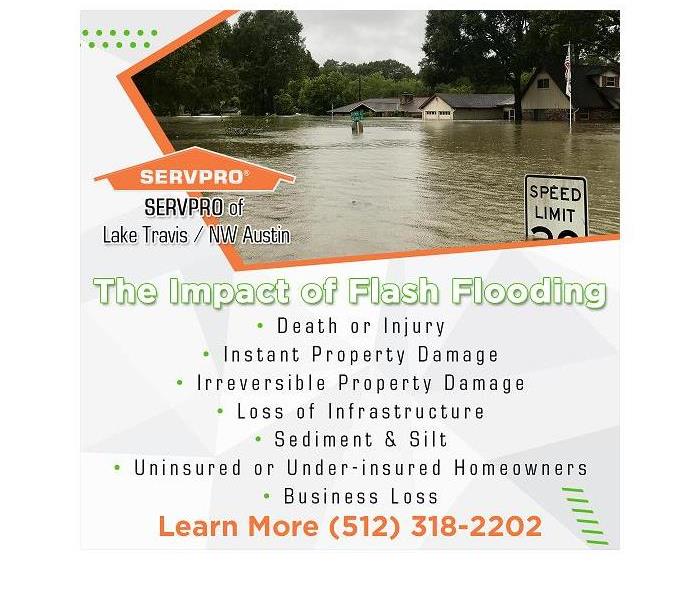Flash flooding and its impact
8/24/2021 (Permalink)
Blog summary: The SERVPRO blog educates homeowners about flash flooding and its impact.
All about flash flooding
Flash flooding can wreak havoc on unsuspecting residents in a matter of hours. But a basic understanding of flash flooding can help homeowners prepare better for the eventuality. SERVPRO of Lake Travis / NW Austin, a storm damage restoration service, discusses flash flooding and its impact in detail below.
What is Flash Flooding?
Flash floods can be caused by heavy rainfall during thunderstorms or breaks in dams or levees and/or mudslides. It is defined as a flood that occurs within 6 hours of heavy rainfall or other reasons, but it can occur in as little as a few minutes as well. It is usually quite dangerous as it combines a flood’s normal potential with unpredictability and a wildly rapid timeframe.
What causes flash flooding?
Here are a few factors that determine the swiftness and location of flash flooding:
- Intensity of rainfall
- Location and distribution of rainfall
- Land use and topography
- Vegetation type and growth/density
- Soil type
- Soil water content
Despite these factors, urban areas are more susceptible to flash flooding than others due to the presence of buildings and concrete. The capacity of the soil to absorb water in these areas is much lower than in other areas.
Regions near rivers or large streams are also at an increased risk. If the flow of water drastically changes from upstream, it can cause the river or body of water to expand to dry land, resulting in a flash flood. Ravines and mountains face similar scenarios.
The FEMA (Federal Emergency Management Agency) flood map helps determine an area’s risk for flooding. Flood insurance is determined by the location of the property in a flood-risk zone. A flood insurance policy from the National Flood Insurance Program (NFIP) marks the difference between recovery and a devastating financial loss.
The Impact of flash flooding
Death or Injury
The unpredictable nature of flash floods makes them very dangerous. Due to the lack of warning, many people get injured or killed by these floods. Often these flash floods occur at night while people are sleeping. According to the National Weather Service, flash floods are the biggest cause of weather-related deaths in the US.
Instant Property Damage
With the combination of the force of water and the large debris that flash floods carry, the amount of structural damage can be immense. The damage caused to homes can make them uninhabitable and disrupt lives.
Irreversible Property Damage
Rooms, vehicles, and other contents that came in the path of floodwaters may not be salvageable. Homes become susceptible to harmful molds. Submerged vehicles bear irreparable water damage to the engine and other critical components.
Loss of Infrastructure
Structural damage to bridges and roadways makes travel impossible. Power, telephone, and cable lines may be damaged by flash floods. The contaminated floodwaters pollute groundwater and make tap water unfit for consumption.
Sediment & Silt
Floodwaters carry sand, silt, and other debris with them as they travel. When the velocity of the flash flood slows, it begins depositing this debris that can make travel difficult. Removing this debris is another huge expense.
Uninsured or Under-insured Homeowners
Since the usual homeowner’s insurance doesn’t cover flood damage, many homeowners experience huge financial losses. Homeowners must figure out if their property lies in a flood-risk zone and must get flood insurance through the NFIP.
- Business Loss
Flash floods usually wreak havoc on homes and businesses alike. The extent of the damage may delay the recovery process and therefore cause further losses to business owners.
Just one inch of floodwater can cost $25,000 in damages. Poor drainage systems, neighborhood construction, and broken water mains can also cause flooding or exacerbate the flash flood caused by rainfalls. Flash floods cannot be controlled or stopped, but homeowners can educate themselves, and be prepared in case of this natural calamity.
When the storm is over, SERVPRO’s storm damage restoration team can help restore and rebuild properties, and help homeowners return to their lives as swiftly and smoothly as possible.
Why SERVPRO?
- SERVPRO uses state-of-the-art equipment to bring the damaged property back to its original state. SERVPRO of Lake Travis/NW Austin is always updating its fleet and equipment so clients in Lake Travis/NW Austin, or anywhere else can quickly access the services.
- With over 1,700 US and Canadian Franchise locations, SERVPRO is strategically positioned to respond faster to an emergency of any magnitude.
- The SERVPRO staff is highly trained in property damage restoration. They receive initial in-house training and constant skill up-gradation at the corporate training facility and also acquire the regular IICRC-industry certification.
For storm damage restoration services in Spicewood and surrounding areas, call SERVPRO of Lake Travis/NW Austin today at (512) 318-2202.

 24/7 Emergency Service
24/7 Emergency Service
